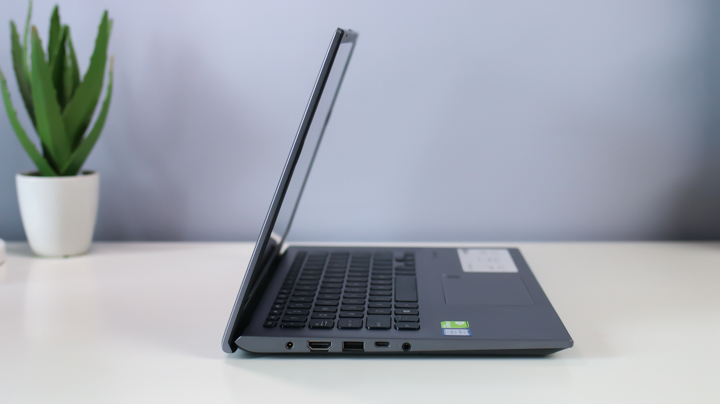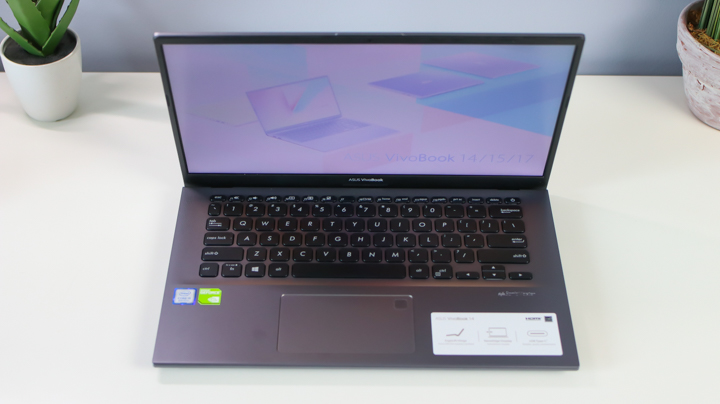ASUS recently released the VivoBook X14 notebook in the Philippines. It sports a 14-inch NanoEdge screen with slim bezels, 8th-gen Intel Core i3 chipset, NVIDIA GeForce MX230, and a price tag of almost PHP 33K. If you’re looking for a notebook within that budget, then check out our full review of the ASUS VivoBook 14 X412F below.

Table of Contents
The ASUS VivoBook 14 X412F is that kind of laptop that looks great for its price. Although the whole body is plastic, the design and finish look beautiful, even for this Slate Grey model, with a finish similar to graphite metal.

Lift the lid, and you will notice that it also features the ErgoLift hinge which tilts the keyboard, allowing for a more comfortable typing experience and airflow.

Also noticeable is the NanoEdge screen with a thin 5.7mm bezel and a dimpled finish. It boasts a screen-to-body ratio of 87%. Found on the top bezel are the HD webcam and microphones.

As for the keyboard, the keys have a matte finish, decently spaced, and relatively quiet. However, the model that we have doesn’t have backlighting, so typing in the dark can be a challenge.

The trackpad is smooth and has a decent width but doesn’t offer much in height. The fingerprint scanner, which works fast, is also found here and takes some space, which feels a bit cramped at first. The left and right clicks, on the other hand, feels soft but clicky.

For the ports, on the left, we have the power, HDMI, USB 3.1 Type-A, USB 3.1 Type-C, and 3.5mm audio combo jack.

On the right, we have the microSD card slot, USB 2.0 Type-A, and Kensington lock.

At the bottom, there are plastic nubs for the feet, air vents, and speaker grills on the left and right side.
As for the size, it’s more compact than your usual 14-inch laptop thanks to the slimmer bezels. It’s a bit hefty though at 1.5kg but still easy to lug around.

The 14-inch screen with HD (1366 x 768) resolution is bright and looks decent, but the colors appear washed out. Viewing angles are also not so great as the color shifts when you change perspective. In my experience, it is best viewed in an angle that is direct to your line of sight.

Although there’s plenty to be desired when it comes to the color vibrancy and viewing angles, it should be fine if you’re just casually watching videos, basic photo editing, MS Office work, and web browsing although don’t expect it to handle direct sunlight well.

When it comes to audio, the dual speakers are disappointing as it is weak even at 100% volume and sounds hollow. Our mid-range smartphone is even louder. The use of an external Bluetooth speaker or headphones is highly recommended.
The VivoBook 14 X412F runs on Windows 10 Home 64-bit with some apps preinstalled like the ASUS AudioWizard and McAfee LiveSafe and WebAdvisor. The latter can be easily uninstalled if you prefer other anti-virus protection.

Storage-wise, ASUS is offering a 256GB of SSD for this model, which is limited. It’s highly recommended to have an external hard drive to house bigger files like photos, videos, and others that might take up significant space
Powering the VivoBook 14 X412F is an Intel Core i3-8145U CPU, NVIDIA GeForce MX 230 GPU, Intel UHD 620 integrated graphics, 4GB RAM, 256GB SSD (our review unit comes with a 512GB SSD), and Windows 10 Home. This kind of configuration can handle most productivity tasks like MS Office work and photo editing. Some games are playable, like World War Z, but only at their lowest graphic settings.

The biggest bottleneck here is the 4GB RAM. It is very limited and won’t be able to handle numerous Chrome tabs. Having an SSD is great although 256GB is a little insufficient, and we suggest using an external hard drive to handle your multimedia files. Check out the benchmark scores below.
• 3D Mark TimeSpy – 911
• 3D Mark FireStrike – 2,777
• PC Mark 10 – 3,754
• Geekbench – 4,209 (Single-Core), 11,396 (Multi-Core), 47,834 (OpenCL)

The VivoBook 14 sports a 37Whr 2-cell lithium-polymer battery. So far, we’re getting around 5 hours of use in Best Performance and 75% brightness when mostly used for browsing the web, writing articles, and watching videos on YouTube. Charging, on the other hand, takes about 2 hours.
What the ASUS VivoBook 14 X412F is offering is a laptop with a nice design, generous I/O, a nice-looking screen with thin bezels, and good price-to-performance ratio. At PHP 32,995USD 562INR 47,665EUR 536CNY 4,095, it doesn’t hurt the pockets. If you’re a student who needs to work on documents or a casual user who spend most of his/her time browsing the web, this laptop will get the job done.

ASUS VivoBook 14 X412F specs:
14-inch HD (1366 x 768) NanoEdge display
Intel Core i3-8145U CPU
NVIDIA GeForce MX 230 GPU
Intel UHD Graphics 620
4GB DDR4 RAM
256GB SSD
WiFi 802.11 ac
Bluetooth 4.2
HD Webcam
USB 3.1 Type-C
USB 3.1 Type-A
USB 2.0 Type-A
HDMI 1.4
microSD card reader
3.5mm audio combo jack
2x stereo speakers
Fingerprint scanner
Windows 10 Home
37Whr 2-cell lithium-polymer battery
322.4 x 212.7 x 19.5 mm
1.5 kg
What we liked:
• Nice design
• Thin bezels
• Decent performance
• Plenty of ports
• Good pricing
What we didn’t:
• Limited RAM and storage
• Disappointing speakers
• Poor viewing angles

YugaTech.com is the largest and longest-running technology site in the Philippines. Originally established in October 2002, the site was transformed into a full-fledged technology platform in 2005.
How to transfer, withdraw money from PayPal to GCash
Prices of Starlink satellite in the Philippines
Install Google GBox to Huawei smartphones
Pag-IBIG MP2 online application
How to check PhilHealth contributions online
How to find your SIM card serial number
Globe, PLDT, Converge, Sky: Unli fiber internet plans compared
10 biggest games in the Google Play Store
LTO periodic medical exam for 10-year licenses
Netflix codes to unlock hidden TV shows, movies
Apple, Asus, Cherry Mobile, Huawei, LG, Nokia, Oppo, Samsung, Sony, Vivo, Xiaomi, Lenovo, Infinix Mobile, Pocophone, Honor, iPhone, OnePlus, Tecno, Realme, HTC, Gionee, Kata, IQ00, Redmi, Razer, CloudFone, Motorola, Panasonic, TCL, Wiko
Best Android smartphones between PHP 20,000 - 25,000
Smartphones under PHP 10,000 in the Philippines
Smartphones under PHP 12K Philippines
Best smartphones for kids under PHP 7,000
Smartphones under PHP 15,000 in the Philippines
Best Android smartphones between PHP 15,000 - 20,000
Smartphones under PHP 20,000 in the Philippines
Most affordable 5G phones in the Philippines under PHP 20K
5G smartphones in the Philippines under PHP 16K
Smartphone pricelist Philippines 2024
Smartphone pricelist Philippines 2023
Smartphone pricelist Philippines 2022
Smartphone pricelist Philippines 2021
Smartphone pricelist Philippines 2020